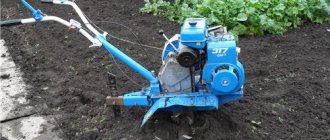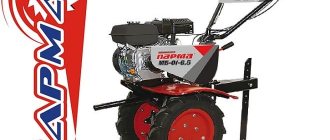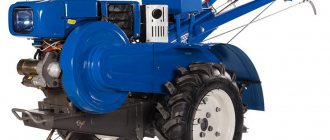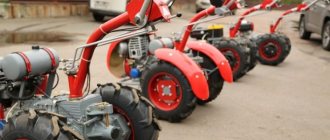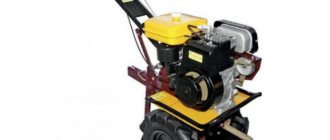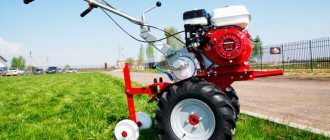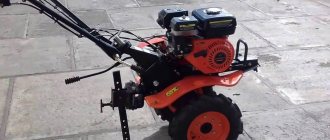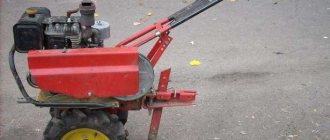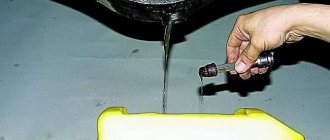Walk-behind tractors are quite serious and expensive gardening equipment.
If you want it to fully perform its functions, serve for a long time and reliably, then you need to carefully care for it and follow all operating recommendations prescribed by the manufacturer. When you bought equipment, it is important to know how to start the walk-behind tractor correctly. There is a certain sequence of actions, consisting of preparing the equipment for launch and its immediate launch.
Description
Motoblocks "Cascade" have proven themselves as reliable farmer's assistants. These are productive, durable machines capable of working with a full range of mounted implements, performing the functions of a cultivator, plowing machine, mower, snow blower and many others.
Motoblock Cascade series MB 6-06
In order for the walk-behind tractor to work without failures for many years, you must follow the instructions during its operation.
Timely maintenance of the walk-behind tractor is also important. For the Cascade, the maintenance schedule is the same as for any other household walk-behind tractor:
- scheduled maintenance: once a season, at the end of seasonal work and before it begins (at the beginning and end of spring, at the beginning and end of summer, etc.);
- regular mini-inspection - every day upon completion of work and turning off the walk-behind tractor, as well as an external inspection in order to identify damage, chipped paint, etc.;
- winter storage - is allocated to a separate maintenance category, since it involves draining all fuels and lubricants and storing the walk-behind tractor in a room with a positive temperature; upon completion of the winter “preservation” the unit is refilled with fuel and lubricants;
- annual engine prevention (detecting faults, eliminating them, maximizing the service life of the motor and other key components of the unit).
Next, we will look at the basic rules and requirements for fuels and lubricants, the process of starting and running in the Cascade walk-behind tractor, as well as the most common malfunctions of these devices.
Installation completed
The starter on a walk-behind tractor is an important component of the entire structure, so every farmer needs to know how to repair it and install it correctly.
Tags: elements, handle, types, required, installation, special, similar, time, mechanical, type, most, kickstarter, fastening, reliable, beginning, order, study, necessity, algorithm, came out, assemble, parts, removal, manufacturer, force, way, rule, power, malfunction, dismantling, machine, usually, heat, read, answers, battery, agricultural, longer, quickly, enough, start, carefully, term, jerk, certain, will need, inside, central, system, example
Choosing fuels and lubricants - what kind of oil and fuel is needed?
All “Cascade” walk-behind tractors are intended for domestic use; they are equipped with gasoline engines from various manufacturers (Russia, China, Japan, USA). The oil for the Cascade walk-behind tractor must be selected according to the type of engine - for gasoline, four-stroke engines, as well as based on the season of operation (summer-winter) and the type of cooling; in the case of the Cascade, cooling is carried out using air blowing.
Engine Lifan 168F-2 6.5 hp Engine Lifan 6.5 Engine Lifan 170F Engine Lifan LF177
There are so-called all-season oils; many farmers prefer these types of oils.
- Recommended oil for summer: mineral type 4TD STANDARD SAE 30
- Recommended oil for winter: synthetic 4TD ULTRA SAE 5W-30 or semi-synthetic 4TD PREMIUM SAE 10W-30
- Gearbox oil: SAE80W90 - universal, suitable for gearboxes of any gasoline walk-behind tractor.
- Gasoline: AI-92, AI-95, AI-80.
First launch and testing of the "Cascade" walk-behind tractor
The first start-up of the Cascade walk-behind tractor is just as important as subsequent correct use. The more carefully you handle the unit, the longer the equipment will last you.
How to perform the first launch:
- make sure that the walk-behind tractor is filled with gasoline and oil;
- check the quality of the assembly, the correct connection of the mechanisms;
- put the gear adjustment knob in the neutral position, then start the engine and, having selected the required gear, press the drive lever forward;
- Do not press the forward and reverse handles at the same time;
- It is also prohibited to change gears if the forward/reverse gear lever is in the pressed position.
Running in the "Cascade" walk-behind tractor is carried out in several stages:
- the first stage is idling without load, on average 5 minutes in each gear;
- second stage - work at 1/3 power, 1 hour in each gear;
- third stage - work at 2/3 engine power for 1 hour in each gear.
The total running-in time should be 20 working hours.
If the walk-behind tractor is not new, there is no need to run it in. During break-in, it is prohibited to: load the walk-behind tractor at full capacity, transport more than the recommended (maximum permissible) weight on a cart or trailer, or perform complex work such as plowing virgin soil.
Design of a manual starter for a walk-behind tractor
The device consists of:
- a body made in the form of a drum;
- large and small springs;
- reeds and washers;
- reels and cord;
- fastening parts.
The cord itself is fixed on a reel installed in the central part of the drum. A special large ring spring is placed in the drum around the axis and helps the reel return to its initial state after scrolling. As you can see, assembling such a mechanism is quite simple.
As for the working process, everything is even simpler here: after a person jerks the starter handle with a sharp movement, the mechanism itself comes into action and transmits the initial rotation to the engine. For better acceleration, pull the handle twice.
But, as is usually the case, nothing works forever and even such reliable devices sometimes fail. Be that as it may, there is no need to be upset, because all problems can be corrected.
The main causes of breakdowns - why doesn’t the walk-behind tractor start?
The "Cascade" walk-behind tractor, like any gasoline walk-behind tractor, sometimes may not start or may not start on the first try. Possible causes of this problem could be:
- too low temperature (excessive cooling of engine, fuel);
- small amount of fuel, insufficient to turn on and operate;
- low or no oil level;
- incorrect assembly;
- clogged carburetor jets;
- oxidation of contacts in the electric starter;
- The spark plug is faulty or the spark plug needs to be cleaned;
- wire insulation is broken;
- low fuel quality
do not violate the recommendations for fuels and lubricants! This will accelerate wear on the piston group and the engine as a whole.
There is no spark on the walk-behind tractor: options for fixing the problem
The most common cause of walk-behind tractor malfunctions is failures in the ignition system. The problem may be related to the cap, magneto, spark plug or high-voltage equipment wire.
If the spark is lost, you need to do the following:
- Check the ignition system for blockages. Often there is no spark because water or dirt has entered;
- Check for contact between the main electrode and the spark plug cap;
- Make sure that all electrodes are intact and that there is a gap between them. You can use a special probe. The optimal gap is 0.8 millimeters;
- Carbon deposits are removed from the insulator and metal parts of the ignition unit;
- The spark plug is unscrewed and checked for oil stains. Existing oil stains and thick carbon deposits must be thoroughly cleaned and the spark plug dried. You also need to dry the cylinder of the unit by pulling out the starter cable;
- If after diagnostics the cause of the malfunction is not identified, the spark plug needs to be replaced. This part has a low price, but it is advisable to give preference to more expensive options. They are distinguished by reliability and durability.
https://youtube.com/watch?v=IXr9qtWO0f0
Main malfunctions of walk-behind tractors "Cascade"
What malfunctions can occur in the operation of Cascade walk-behind tractors? Let's take a closer look at possible causes not related to engine malfunction:
- The car does not go forward/reverse. Possible cause: belt break or insufficient tension. Solution: replacing the belt, adjusting the tension.
- There was a delamination of the belt on the V-belt drive. Possible cause: excessive belt wear. Solution: replacing the belt.
- Skidding of soil areas during plowing. Reason: insufficient weight of the unit. Solution: use weights and lugs.
How to repair a manual starter for a walk-behind tractor with your own hands?
- Before starting all procedures, it is advisable to find a diagram from the manufacturer or use the document presented on our website;
- You should prepare a wrench that will be needed in the future to unscrew and remove nuts;
- Before disconnecting the starter itself, it would be a good idea to take a photo of everything so that you can reassemble it correctly in the end;
- Unscrew the washer located in the central part of the drum;
- Inspect all the elements inside and look for damaged parts.
The main thing is to be very careful with all small things so as not to lose them. Most often, starter repair involves updating unusable parts. For example, replacing the starter cord will be important if it is completely frayed or torn.
With a large spring, everything is somewhat more complicated, because there are special hooks at the ends of the attachment points. If they are missing, you need to heat these very ends and bend them in the appropriate direction. An important point: you should not try to return the element to its former functionality when there is pronounced metal fatigue. Replacement will be the best solution.
Motoblock structure, engine diagram
The design of the carburetor of the Cascade walk-behind tractor is shown in Figure 2.
Figure 2. Carburetor “Cascade”
Tuning (adjustment) of the carburetor of the Cascade walk-behind tractor is carried out according to the standard scheme:
- the engine must warm up;
- then the position of the throttle valve is changed using the adjusting screw;
- after this, the idle speed is reduced to a minimum, the operator must achieve a uniform sound from the engine;
- then the maximum and minimum engine speeds are adjusted three to four times until the sound is smooth and stable at the selected throttle position.
Ignition of the "Cascade" walk-behind tractor
Sometimes the problem of starting and operating a walk-behind tractor lies in the ignition itself. The ignition adjustment of the Cascade walk-behind tractor is performed based on the engine type. Each engine comes with an instruction manual, so it needs to be studied in detail.
- The engine starting mechanism - the starter - is designed to spin the crankshaft.
- The electronic ignition system ensures uninterrupted sparking at the spark plug.
Why does it stall under load?
“The walk-behind tractor stalled during operation” - you can often hear from the mouths of users of these units. The problem may be a malfunction of the fuel supply system or ignition system.
In the first case, check the spark plug. If it is not wet, it means that fuel liquid does not enter the engine cylinder.
Important! Pay attention to the fuel level. The problem could also be with the fuel valve if it is tight.
In this video you will find out why the walk-behind tractor does not develop power: In another case, also make sure that the spark plug is working properly. It shouldn't be wet. Otherwise, you will need to adjust the ignition system again. For this:
- remove the cover that protects the ignition system;
- rotate the flywheel of the power unit until the contacts open;
- determine the distance between such elements of the ignition breaker as the anvil and the hammer;
- rotate the flywheel until the piston reaches its highest point;
- move the flywheel to a position where the clutch engages;
- turn the flywheel again in the opposite direction;
- fix the distance between the interrupting contact and the cam at 0.33 mm;
- securely fasten the cam and return the protective cover to its place.
Now the motor is working again and it will withstand a stable load.
Important! So that, if such situations arise again, we can promptly begin repairs. Otherwise, parts and main mechanisms will wear out and deteriorate much faster.
In addition to the above, other reasons for failure of the ignition system:
- muffler contamination;
- incorrect carburetor settings;
- mechanical defects in the electrical circuit.
